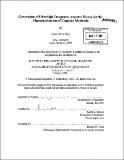| dc.contributor.advisor | Keith A. Nelson. | en_US |
| dc.contributor.author | Choi, Jaime Dawn, 1976- | en_US |
| dc.contributor.other | Massachusetts Institute of Technology. Dept. of Chemistry. | en_US |
| dc.date.accessioned | 2006-03-24T18:30:26Z | |
| dc.date.available | 2006-03-24T18:30:26Z | |
| dc.date.copyright | 2005 | en_US |
| dc.date.issued | 2005 | en_US |
| dc.identifier.uri | http://hdl.handle.net/1721.1/30209 | |
| dc.description | Thesis (Ph. D.)--Massachusetts Institute of Technology, Dept. of Chemistry, 2005. | en_US |
| dc.description | Page 207 blank. Vita. | en_US |
| dc.description | Includes bibliographical references. | en_US |
| dc.description.abstract | A discussion of the anomalous low-temperature thermal properties of amorphous materials is first given as a theoretical framework in which the rest of the thesis is treated. The theory models the form and function of microscopic dynamical and structural features that are thought to be common to amorphous materials, which interact strongly with ultrahigh frequency acoustic waves and creating the anomalies. The model has been found to well reproduce the measured anomalous thermal conductivity of silica glass. Separately, an experiment which utilizes impulsive stimulated thermal scattering is used to measure the anomalous low-temperature thermal conductivity of a molecular glass, glycerol. The results, taken in the context of the aforementioned theory, illustrate the ambiguity of using a macroscopic measurement to quantify microscopic parameters. However the validity of the microscopic assumptions of the theory has heretofore been difficult to test directly due to a lack of a proper experimental method. The remainder of the thesis is devoted to developing a technique of generating ultrahigh frequency acoustic waves, which can be used to directly probe the dynamics and structure believed to dominate the low-temperature thermal properties of amorphous materials. The generation of ultrahigh frequency tunable narrowband acoustic waves is accomplished with a novel retroreflection-based ultrafast pulse shaper. It generates optical pulse sequences of frequency tunable between 2-2000 GHz through movement of a single delay line. Optical to acoustic conversion by aluminum transducers yields acoustic waves with bandwidth limited by the metal temporal response to 2- 500 GHz. The detection of the ultrahigh frequency acoustic waves is accomplished with a novel grating-based interferometer. | en_US |
| dc.description.abstract | (cont.) The alignment, flexibility, and calibration of the interferometer is described. Lastly the use of the technique is illustrated for the characterization of the structure and dynamics of silica glass, the prototypical amorphous material, at room temperature and at 20 K. The room temperature results are considered in terms of the only other data available in the literature, and the 20 K data are considered in terms of the theory of amorphous materials, as no other information has been published in this temperature and frequency range. Both results suggest that current models of amorphous materials be reconsidered. | en_US |
| dc.description.statementofresponsibility | by Jaime Dawn Choi. | en_US |
| dc.format.extent | 207 p. | en_US |
| dc.format.extent | 11068156 bytes | |
| dc.format.extent | 11094729 bytes | |
| dc.format.mimetype | application/pdf | |
| dc.format.mimetype | application/pdf | |
| dc.language.iso | eng | en_US |
| dc.publisher | Massachusetts Institute of Technology | en_US |
| dc.rights | M.I.T. theses are protected by copyright. They may be viewed from this source for any purpose, but reproduction or distribution in any format is prohibited without written permission. See provided URL for inquiries about permission. | en_US |
| dc.rights.uri | http://dspace.mit.edu/handle/1721.1/7582 | |
| dc.subject | Chemistry. | en_US |
| dc.title | Generation of ultrahigh frequency acoustic waves for the characterization of complex materials | en_US |
| dc.type | Thesis | en_US |
| dc.description.degree | Ph.D. | en_US |
| dc.contributor.department | Massachusetts Institute of Technology. Department of Chemistry | |
| dc.identifier.oclc | 60696525 | en_US |
